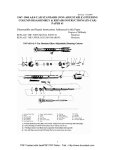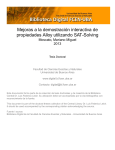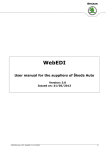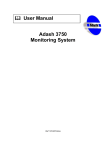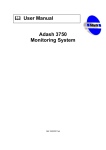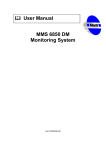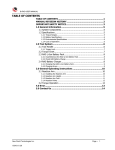Download (Late) - 1968 CORVETTE STANDARD
Transcript
Last Revision: 03SE2012 1967 (Late) - 1968 CORVETTE STANDARD (NON-ADJUSTABLE) STEERING COLUMN DISASSEMBLY & REPAIR INSTRUCTIONS PAPER #2 Disassembly and Repair Instructions Addressed in this Paper Degree of Difficulty Page DROP OR REMOVE STEERING COLUMN FROM VEHICLE Moderate 2&3 REPLACE LOWER COLUMN BEARING Moderate 4&5 STEERING SHAFT LENGTH CHECK Moderate 5 STEERING COLUMN ALIGNMENT CHECKS Easy 8 How the Paper is Setup There are a limited number of standard steering column service procedures that are addressed in this paper. This paper starts at the point where the steering wheel and horn parts are already removed from the steering column. These procedures were described in detail in 1967-68 Corvette Standard (Non-Adjustable) Steering Column Disassembly & Repair (D&R) Paper #1. The turn signal switch and upper bearing are still intact on the column. This paper includes drawings of the steering column installations for the two specific years. It also contains a corrected steering column blowup drawing that was also included in D&R Paper #1. Types of Steering Columns Addressed in this Paper The 1967 Corvette standard steering column is included in this paper because it is so close in design to the 1968 C3 model. However, they will not interchange because they have different attachment points under the dash. So we are really looking at unique, one year only steering columns. Therefore, parts are very rare (and expensive.) Please note that I believe that the instructions in the 1967 and/or 1968 Chevrolet Chassis Service Manuals are confusing at best. The 1967 manual does not reflect the revised lower bearing design that was introduced early during 1967 production. The 1968 manual confuses 1967 lower column attaching procedures with the new 1968 design. The 1967-68 Corvette steering columns (and 1967, 68, 69 Corvair) were quite unique from the rest of the General Motors columns in that the steering column jackets were smaller in diameter than any other Saginaw steering columns (for just those years.) They are also unique in that they use virtually no parts from earlier years nor do they use any parts from the second generation, function locking steering columns that followed in 1969. Specifically this paper covers the 1967 (Late) and 1968 Corvette standard steering columns that are quite similar to each other and use several common parts. All part numbers in parenthesis ( ) refer to Steering Column Mounting Pics on page 3. All part numbers beginning with # refer to the Steering Column Blowup on page 4. 1 The 1967 model year saw the introduction of the General Motors first generation, energy absorbing, collapsible steering columns. Right after the very start of production the lower steering column bearing was revised and a clamp, nut, and bolt were added to retain the bearing in place. This is why we identify the steering shaft and lower bearing parts for the 1967 Corvette in this paper as being (Late) revisions. They were the same as the 1968 lower bearing parts. A Words of Caution: To maintain the energy absorbing function of the steering column, always replace screws, bolts, and nuts with identical fasteners as specified. Disconnect your car’s battery whenever you work on the steering column. Instructions for Dropping and/or Removing the Steering Column In order to replace the lower steering column bearing the steering column first must be removed from the car. Upper End 1967 – The steering column has two separate plastic covers and a collar called an escutcheon. The covers attach together with screws. Remove the covers and detach the escutcheon from the instrument cluster. (Picture included in D&R Paper #1, Page 3.) 1968 - Remove the fasteners and the four plastic covers that enclose the upper end of the steering column. Remove the four fasteners and the closeout panel that is underneath the column. (Picture included in D&R Paper #1, Page 4.) 1967-68 All Detach air ducts, crossover bars, and any other dash components that prevent the steering column from dropping straight down from the instrument panel structure. Disconnect the steering column curved turn signal switch connector from the body harness. 2 Dropping and/or Removing the Steering Column (Continued) Lower End Mounting – 1967 Remove the clamp bolt (5) and washer (6) from the support assembly (1) on the engine compartment side of the lower dash panel. You should be able to pry the clamp open sufficiently to be able to clear the thumb bumps on the lower end of the steering column. Use a crayon or piece of chalk to mark the orientation of the steering column shaft to the steering column flange. Remove pinch bolt (7) from the steering column flange and spring the flange open with a large screwdriver. Lower End Mounting – 1968 If you have a manual transmission, you may find a fairly heavy clutch pedal spring attached to support (A) and to the Z-bar. You should detach one end of the spring at this time. Hint! Detach the clutch pedal rod from the Z-bar. This will allow the Z-bar to rotate rearward and take some tension off the spring. Use a crayon or piece of chalk to mark the orientation of the steering column shaft to the steering column flange. Remove pinch bolt (J) from the steering column flange. Spring the flange open with a large screwdriver. Go back inside the car and remove two screws (K). Column Removal Procedures 1967-68 Note: The steering column flange is shown loose from the flexible coupling in both of the above mounting pictures. However, in order to remove the steering column from the car I do not think that it needs to be detached from the flexible coupling. For one thing I am quite sure that the steering column flange is too large to fit through the holes in support plates 1967 (1) or 1968 (A). Therefore my removal procedure detaches the steering column shaft directly from that flange (leaving the flange attached to the flexible coupling assembly.) Unfasten the three vertical bolts & washers 1967 (8 & 9) or bolts 1968 (H) that hold the column up into the dash. NEVER just remove the three vertical main mounting bolts that hold the steering column up into the dash and let the column “hang” by the attachments at the flexible coupling and the plates and fasteners on the lower dash panel. Letting the column “hang” in that manner puts very high loads on the steering column jacket and the lower bearing. Now pull the column straight back, disconnecting the column shaft from the steering column flange. 3 Remove and Replace the Lower Bearing Now that the steering column is out of the car, place it on a suitable workbench. Do not use a bench vise to clamp around the steering column mast jacket. It is actually quite fragile. Clamp on the heavy column mounting bracket. Do not clamp on the aluminum capsules. The following bearing replacement procedures should be straight forward AS LONG AS THE PARTS ARE NOT ALL CORRODED TOGETHER. If you find a lot of corrosion on your lower column parts, it is a good idea to soak them in penetrating oil for a day or two before trying to remove them. Option 1 – Remove Lower Bearing with Steering Shaft In Place The Chassis Service Manuals are unclear as to exactly how to remove the lower column bearing #5 for service. The bearing case is a press fit to the mast jacket #3. It is possible that just removing the lower bolt, nut, and clamp #19, the spacer #18, packing #17, spring #16 and washer 7802124 may allow sufficient access to be able to pull the bearing from the lower end of the mast jacket and slide if off the steering shaft #20. So I would suggest trying this approach first. Note there is a spring seat 262141 and spring #21 behind the seal. Do not lose them. Also note the orientation of the spring seat. Option 2 – Remove Lower Bearing and Steering Shaft Through Lower End Remove the c-clip retaining ring #13, the thrust washer #14 and the wave washer #15. Push the steering shaft down through the mast jacket. When it comes out, the lower bearing and all the associated parts will come with it. 4 Option 2 – Remove Lower Bearing and Steering Shaft (Continued) Remove the nut, bolt, & clamp #19, the spacer #18, packing #17, spring #16, washer 7802124, and the lower bearing #5. Behind the lower bearing will be the spring seat 262474 and another spring #21. Make note of the orientation of the spring seat. Locating a Replacement Lower Bearing The 1967 (late) and 1968 Corvette standard steering columns use a lower bearing that is unique to just those two years. (Possibly the energy absorbing Corvair steering column (1967, 68, & 69) may use the same lower bearing as well.) I have found the lower bearing at this location. Doc Rebuild www.docrebuild.com 1-800-866-9362 67Late-68 Lower Shaft Bearing #6521138 Guide Bushing Lubrication There is reference on the blowup picture to a plastic guide bushing that is up inside the mast jacket. While the lower bearing and steering shaft are out of the mast jacket, now is a good time to lubricate that bushing. It should be a light press fit and located about 8.7 inches (1967) or 7.6 inches (1968) up inside the mesh section of the mast jacket from the lower end. You want to apply some lithium based chassis grease to the bushing. Steering Shaft Checks The overall length of the steering shaft assembly (for both years) should be 37.49 inches. The steering shaft assembly consists of two pieces. A solid upper shaft where the steering wheel hub attaches and a tubular lower shaft where the steering column flange attaches. They are held together by injected plastic. If the plastic has been sheared and the overall length of the steering shaft assembly measures less (or more) than 37.49 inches you might consider pulling the shafts apart and reassembling them with a dab of epoxy glue on the solid upper shaft in the area of the injected plastic. With respect to pulling the steering shafts apart, you will probably find that they only extend so far but then abruptly will not pull apart any further. It is probable that the solid upper shaft had the end inside the assembly staked over. With the shaft assembly out of the steering column you may need to “slam pull” the two shafts to peen over the stake and get the two shaft to slide apart. To provide for an easier reassembly of the two shafts use a file to manicure the stake on the solid shaft after it is apart. Now is a good time to check that the index (or chisel) mark on the very end of the upper shaft is aligned with the notch that is machined across the splines on the lower shaft. 5 Lower Bearing Installation All - Apply a thin coating of a good lithium based chassis grease to all friction surfaces as you reassemble the column parts. The steering column assembly drawings have a note that indicates that with the steering shaft in the straight ahead position (notch on lower end of the steering shaft at 12 o’clock); the clamp bolt should be vertical, passing through the 3 o’clock position, with the nut on top (same as clamp shown on page #2). I cannot think of a functional reason why the clamp has to be orientated but all of the drawings are specific to this requirement. Option 1 – Lower Bearing Reassembly (Steering Shaft In Place) Slide a new bearing up the steering shaft and lightly tap it into the mast jacket. It is a press fit. Install washer (7802124), spring #16, packing #17, spacer #18, and clamp, bolt, & nut #19 on the end of the steering shaft. Press the clamp up against washer 7802124 or until spring #16 is compressed to its solid height. Tighten clamp nut to 30 ft-lbs. Option 2 – Lower Bearing Reassembly - Install Steering Shaft Through Lower End Slide the steering shaft up into the mast jacket until the round wire retaining ring 5694191 on the shaft stops against the upper bearing. Slide the spring #21 and the spring seat (262474) onto the steering shaft. Did you remember the orientation of the spring seat? (The end of the seat that rides on the steering shaft must be seated against the inner race of the bearing assembly.) Slide the lower bearing onto the steering shaft and tap it into place. Install the washer (7802124), spring #16, packing #17, spacer #18, and clamp, bolt, & nut #19 on the end of the steering shaft. Loosely tighten the nut to hold the parts in place. Reinstall the wave washer #15, thrust washer #14, and the c-clip retaining ring #13 on the upper end. Make sure that the c-clip is fully seated in steering shaft groove. Loosen the clamp nut #19 and press the clamp up against washer 7802124 or until spring #16 is compressed to its solid height. Orient the clamp and tighten nut to 30 ft-lbs. Steering Column Installation This paper assumes that the steering column was correctly installed and positioned into the car previous to it being removed for repair. Therefore the original position of the 1967 support plate (3) and 1968 bracket (B) and support plate (D) would correctly locate the upper end of the steering column. Steering column to instrument cluster gapping procedures can be found in the AIM or other chassis service manuals if needed. Also, it is best to have someone positioned out under the hood to assist in aligning and installing the steering column shaft into the flexible coupling on the gear. 6 Steering Column Installation – 1967 If previously removed, loosely secure the seal (11) and support plate (1) to the engine side of the dash panel with two screws. Otherwise loosen the two screws that hold the support plate to the dash. Feed the lower end of the steering column through the dash. Make sure that the clamp part of the support assembly is between the two thumb bumps on the lower end of the steering column jacket. Insert the steering shaft into the flange on the flexible coupling assembly. Make sure that you align the paint or chalk marks on the flange and steering column shaft for correct orientation of the parts. Loosely install the pinch bolt (7) into the flange. Slide the escutcheon into position on the instrument cluster. Allow the lower dash panel attachment to float as you secure the steering column into the dash with the three vertical bolts (8) and washers (9). Torque the bolts to 20 ft-lbs. Secure the seal and support assembly to the dash panel on the engine compartment side by tightening the two screws to 13 ft-lbs. Tighten the bolt and washer to clamp the lower end of the steering column to the support assembly. Tighten the bolt to 13 ft-lbs. Tighten the pinch bolt to 30 ft-lbs on the steering column flange that is part of the flexible coupling assembly. Steering Column Installation - 1968 Install gasket (G) into toe plate on the steering column. Hold support assembly (A) to dash panel on the engine side of the dash panel. Carefully insert the steering column through the hole in the dash panel and the support assembly. Insert the steering shaft into the flange on the flexible coupling assembly. Make sure that you align the paint or chalk marks on the flange and steering column shaft for correct orientation of the parts. Loosely install the pinch bolt (J) into the column flange. Loosely install bolts (K) through the steering column toe plate and thread them into the floating nuts that are part of the support assembly. Allow the support assembly to float as you secure the steering column into the dash with the three vertical bolts (H). Torque them to 20 ft-lbs. Secure the support assembly to the dash panel by tightening the two screws (K) that are inside the car. Torque them to 13 ftlbs. Tighten the pinch bolt (J) on the flexible coupling flange to 30 ft-lbs. 7 Steering Column Installation (Continued) 1967-68 All – Reattach the curved turn signal switch electrical connector to the vehicle wiring harness. Reconnect ducting and the crossover bar. Refer to Standard Steering Column Disassembly & Repair Paper #1 for reinstalling the steering column covers, turn signal lever, steering wheel hub assembly, steering wheel, and horn parts. Checking for Proper Alignment Important! The following visual checks should be performed with the vehicle on the ground. All four wheels of the vehicle should be supporting vehicle weight. Check for distortion in the rubber flexible coupling disc. The distance from the underside of the steering column flange to the metal reinforcement plate must be within the dimension shown. Next visually check that the flexible coupling stop pins are central in the column flange slots. Turn the steering wheel one quarter turn and recheck the pin to flange centrality. If the pins are not central, you must loosen the support assembly to dash panel and the three vertical column bolts to allow the column to seek a position that is not binding. Follow steering column alignment directions in the AIM or Chassis Service Manual. Then recheck the stop pin to flange slot centrality at both steering wheel positions. Driving checks – Sticking or slow returnability when completing a turn; metallic noise; or an irregular feel as the steering wheel is turning are conditions which may indicate that the steering column needs to be readjusted and realigned. 67-68CorvetteStdColumnD&R#2Rev03SE2012.doc [email protected] 8








